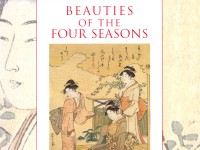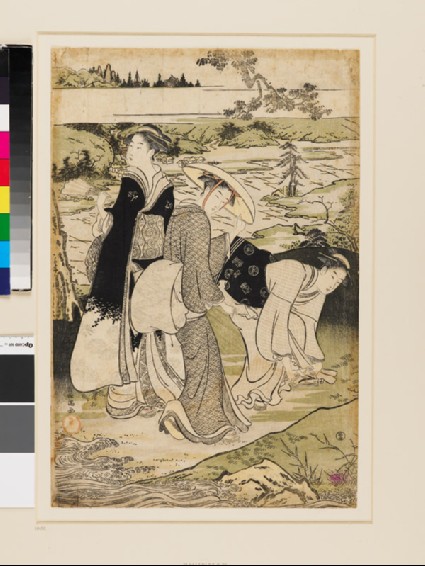Beauties of the Four Seasons
A full catalogue of the Ashmolean’s collection of Japanese bijinga (beautiful women) prints by Mitsuko Watanabe (published Oxford, 2005).

Publications online: 54 objects
Three women by the Jewel River of Takano
-
Literature notes
Kubo shunman was a pupil of Kitao Shigemasa (1739-1820) and produced relaxed and elegant colour prints influenced by Kiyonaga. He was particularly adept at the use of muted colour schemes (benigirai) in the time when the government passed sumptuary regulations during the Tenmei and Kansei periods (1781-1800) forbidding the use of bright colours. 'The six jewel river' is one of the finest works by Shunman. The six rivers are all in different areas of Japan but Shunman’s six rivers from the Mutamagawa series is shown here as a continuous image. The collection of the Ashmolean Museum lacks the fifth image, that of Ogi of Shiga.
This print is of Takano no Tamagawa (the Jewel River of Takano). Three beauties stand near the fast-flowing river during what is probably early autumn. The middle woman wearing a kosode (short- sleeved kimono) has a straw hat to keep off the sun and the woman on the left, with a furisode (long-sleeved kimono) of chrysanthemum design, holds a fan to cool herself; the woman on the right bends over to adjust her tabi. In the background, there are several thatched houses next to rice-fields and what is probably a grave next to the cedar tree. This river is known as a place of kanjō (initiation and purification). -
Details
- Series
- The Six Jewel Rivers
- Associated place
- Date
- c. 1787 - 1788
- Artist/maker
-
Kubo Shunman (1757 - 1820) (designer)
- Associated people
-
Fushimiya Zenroku (active c. 1787 - 1792) (publisher)Daikandō (active 1740s - c. 1914) (publisher)
- Material and technique
- woodblock, printed with water-based vegetable pigments
- Dimensions
-
mount 55.5 x 40.5 cm (height x width)
sheet 38.2 x 25.6 cm (height x width)
- Material index
- Technique index
- Object type index
- No. of items
- 1
- Credit line
- Presented by Mrs Allan and Mr and Mrs H. N. Spalding, 1952.
- Accession no.
- EAX.4088
-
Further reading
Oxford: Ashmolean Museum, 24 August-30 November 2005, Beauties of the Four Seasons, Mitsuko Watanabe, ed. (Oxford: Ashmolean Museum, 2005), no. 23 on pp. 46-47, illus. p. 51
Glossary
vegetable pigments
-
vegetable pigments
Vegetable pigments were used to create coloured dyes for Japanese prints, paintings, and textiles. These pigments often faded over time due to the chemical reactions they underwent.
Location
-
- currently in research collection
Objects are sometimes moved to a different location. Our object location data is usually updated on a monthly basis. Contact the Jameel Study Centre if you are planning to visit the museum to see a particular object on display, or would like to arrange an appointment to see an object in our reserve collections.
Publications online
-

Beauties of the Four Seasons
Kubo shunman was a pupil of Kitao Shigemasa (1739-1820) and produced relaxed and elegant colour prints influenced by Kiyonaga. He was particularly adept at the use of muted colour schemes (benigirai) in the time when the government passed sumptuary regulations during the Tenmei and Kansei periods (1781-1800) forbidding the use of bright colours. 'The six jewel river' is one of the finest works by Shunman. The six rivers are all in different areas of Japan but Shunman’s six rivers from the Mutamagawa series is shown here as a continuous image. The collection of the Ashmolean Museum lacks the fifth image, that of Ogi of Shiga.
This print is of Takano no Tamagawa (the Jewel River of Takano). Three beauties stand near the fast-flowing river during what is probably early autumn. The middle woman wearing a kosode (short- sleeved kimono) has a straw hat to keep off the sun and the woman on the left, with a furisode (long-sleeved kimono) of chrysanthemum design, holds a fan to cool herself; the woman on the right bends over to adjust her tabi. In the background, there are several thatched houses next to rice-fields and what is probably a grave next to the cedar tree. This river is known as a place of kanjō (initiation and purification).
Notice
Object information may not accurately reflect the actual contents of the original publication, since our online objects contain current information held in our collections database. Click on 'buy this publication' to purchase printed versions of our online publications, where available, or contact the Jameel Study Centre to arrange access to books on our collections that are now out of print.
© 2013 University of Oxford - Ashmolean Museum

